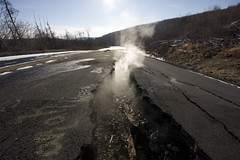All about freezing to death

![]() photo credit: State Library of New South Wales collection
photo credit: State Library of New South Wales collection
From Peter Stark’s “As Freezing Persons Recollect the Snow–First Chill–Then Stupor–Then the Letting Go” (Outside: January 1997):
There is no precise core temperature at which the human body perishes from cold. At Dachau’s cold-water immersion baths, Nazi doctors calculated death to arrive at around 77 degrees Fahrenheit. The lowest recorded core temperature in a surviving adult is 60.8 degrees. For a child it’s lower: In 1994, a two-year-old girl in Saskatchewan wandered out of her house into a minus-40 night. She was found near her doorstep the next morning, limbs frozen solid, her core temperature 57 degrees. She lived.
…
The cold remains a mystery, more prone to fell men than women, more lethal to the thin and well muscled than to those with avoirdupois, and least forgiving to the arrogant and the unaware.
…
Were you a Norwegian fisherman or Inuit hunter, both of whom frequently work gloveless in the cold, your chilled hands would open their surface capillaries periodically to allow surges of warm blood to pass into them and maintain their flexibility. This phenomenon, known as the hunter’s response, can elevate a 35-degree skin temperature to 50 degrees within seven or eight minutes.
Other human adaptations to the cold are more mysterious. Tibetan Buddhist monks can raise the skin temperature of their hands and feet by 15 degrees through meditation. Australian aborigines, who once slept on the ground, unclothed, on near-freezing nights, would slip into a light hypothermic state, suppressing shivering until the rising sun rewarmed them.
…
The exertion that warmed you on the way uphill now works against you: Your exercise-dilated capillaries carry the excess heat of your core to your skin, and your wet clothing dispels it rapidly into the night. The lack of insulating fat over your muscles allows the cold to creep that much closer to your warm blood.
Your temperature begins to plummet. Within 17 minutes it reaches the normal 98.6. Then it slips below.
At 97 degrees, hunched over in your slow search, the muscles along your neck and shoulders tighten in what’s known as pre-shivering muscle tone. Sensors have signaled the temperature control center in your hypothalamus, which in turn has ordered the constriction of the entire web of surface capillaries. Your hands and feet begin to ache with cold.
…
At 95, you’ve entered the zone of mild hypothermia. You’re now trembling violently as your body attains its maximum shivering response, an involuntary condition in which your muscles contract rapidly to generate additional body heat.
…
And after this long stop, the skiing itself has become more difficult. By the time you push off downhill, your muscles have cooled and tightened so dramatically that they no longer contract easily, and once contracted, they won’t relax. You’re locked into an ungainly, spread-armed, weak-kneed snowplow.
…
As you sink back into the snow, shaken, your heat begins to drain away at an alarming rate, your head alone accounting for 50 percent of the loss. The pain of the cold soon pierces your ears so sharply that you root about in the snow until you find your hat and mash it back onto your head.
But even that little activity has been exhausting. You know you should find your glove as well, and yet you’re becoming too weary to feel any urgency. You decide to have a short rest before going on.
An hour passes. at one point, a stray thought says you should start being scared, but fear is a concept that floats somewhere beyond your immediate reach, like that numb hand lying naked in the snow. You’ve slid into the temperature range at which cold renders the enzymes in your brain less efficient. With every one-degree drop in body temperature below 95, your cerebral metabolic rate falls off by 3 to 5 percent. When your core temperature reaches 93, amnesia nibbles at your consciousness.
…
In the minus-35-degree air, your core temperature falls about one degree every 30 to 40 minutes, your body heat leaching out into the soft, enveloping snow. Apathy at 91 degrees. Stupor at 90.
You’ve now crossed the boundary into profound hypothermia. By the time your core temperature has fallen to 88 degrees, your body has abandoned the urge to warm itself by shivering. Your blood is thickening like crankcase oil in a cold engine. Your oxygen consumption, a measure of your metabolic rate, has fallen by more than a quarter. Your kidneys, however, work overtime to process the fluid overload that occurred when the blood vessels in your extremities constricted and squeezed fluids toward your center. You feel a powerful urge to urinate, the only thing you feel at all.
By 87 degrees you’ve lost the ability to recognize a familiar face, should one suddenly appear from the woods.
At 86 degrees, your heart, its electrical impulses hampered by chilled nerve tissues, becomes arrhythmic. It now pumps less than two-thirds the normal amount of blood. The lack of oxygen and the slowing metabolism of your brain, meanwhile, begin to trigger visual and auditory hallucinations.
…
At 85 degrees, those freezing to death, in a strange, anguished paroxysm, often rip off their clothes. This phenomenon, known as paradoxical undressing, is common enough that urban hypothermia victims are sometimes initially diagnosed as victims of sexual assault. Though researchers are uncertain of the cause, the most logical explanation is that shortly before loss of consciousness, the constricted blood vessels near the body’s surface suddenly dilate and produce a sensation of extreme heat against the skin.
…
There’s an adage about hypothermia: “You aren’t dead until you’re warm and dead.”
At about 6:00 the next morning, his friends, having discovered the stalled Jeep, find him, still huddled inches from the buried log, his gloveless hand shoved into his armpit. The flesh of his limbs is waxy and stiff as old putty, his pulse nonexistent, his pupils unresponsive to light. Dead.
But those who understand cold know that even as it deadens, it offers perverse salvation. Heat is a presence: the rapid vibrating of molecules. Cold is an absence: the damping of the vibrations. At absolute zero, minus 459.67 degrees Fahrenheit, molecular motion ceases altogether. It is this slowing that converts gases to liquids, liquids to solids, and renders solids harder. It slows bacterial growth and chemical reactions. In the human body, cold shuts down metabolism. The lungs take in less oxygen, the heart pumps less blood. Under normal temperatures, this would produce brain damage. But the chilled brain, having slowed its own metabolism, needs far less oxygen-rich blood and can, under the right circumstances, survive intact.
Setting her ear to his chest, one of his rescuers listens intently. Seconds pass. Then, faintly, she hears a tiny sound–a single thump, so slight that it might be the sound of her own blood. She presses her ear harder to the cold flesh. Another faint thump, then another.
The slowing that accompanies freezing is, in its way, so beneficial that it is even induced at times. Cardiologists today often use deep chilling to slow a patient’s metabolism in preparation for heart or brain surgery. In this state of near suspension, the patient’s blood flows slowly, his heart rarely beats–or in the case of those on heart-lung machines, doesn’t beat at all; death seems near. But carefully monitored, a patient can remain in this cold stasis, undamaged, for hours.
…
In fact, many hypothermia victims die each year in the process of being rescued. In “rewarming shock,” the constricted capillaries reopen almost all at once, causing a sudden drop in blood pressure. The slightest movement can send a victim’s heart muscle into wild spasms of ventricular fibrillation. In 1980, 16 shipwrecked Danish fishermen were hauled to safety after an hour and a half in the frigid North Sea. They then walked across the deck of the rescue ship, stepped below for a hot drink, and dropped dead, all 16 of them.
…
The doctor rapidly issues orders to his staff: intravenous administration of warm saline, the bag first heated in the microwave to 110 degrees. Elevating the core temperature of an average-size male one degree requires adding about 60 kilocalories of heat. A kilocalorie is the amount of heat needed to raise the temperature of one liter of water one degree Celsius. Since a quart of hot soup at 140 degrees offers about 30 kilocalories, the patient curled on the table would need to consume 40 quarts of chicken broth to push his core temperature up to normal. Even the warm saline, infused directly into his blood, will add only 30 kilocalories.
Ideally, the doctor would have access to a cardiopulmonary bypass machine, with which he could pump out the victim’s blood, rewarm and oxygenate it, and pump it back in again, safely raising the core temperature as much as one degree every three minutes. But such machines are rarely available outside major urban hospitals.
…
You’d nod if you could. But you can’t move. All you can feel is throbbing discomfort everywhere. Glancing down to where the pain is most biting, you notice blisters filled with clear fluid dotting your fingers, once gloveless in the snow. During the long, cold hours the tissue froze and ice crystals formed in the tiny spaces between your cells, sucking water from them, blocking the blood supply. You stare at them absently.
“I think they’ll be fine,” a voice from overhead says. “The damage looks superficial. We expect that the blisters will break in a week or so, and the tissue should revive after that.”
If not, you know that your fingers will eventually turn black, the color of bloodless, dead tissue. And then they will be amputated.
…
You’ve seen that in the infinite reaches of the universe, heat is as glorious and ephemeral as the light of the stars. Heat exists only where matter exists, where particles can vibrate and jump. In the infinite winter of space, heat is tiny; it is the cold that is huge.
All about freezing to death Read More »


